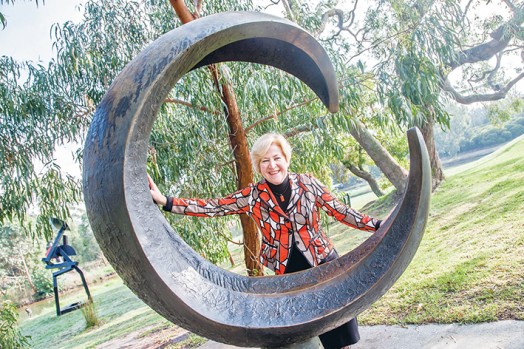
AN ambitious plan to install sculptures at the Frankston station precinct will be considered by council but faces a major funding hurdle.
Former mayor Christine Richards and the six members of the Frankston Business Coalition – a group of businesspeople lobbying political parties for a better deal for Frankston ahead of this year’s state election – have urged councillors to “be bold” and back the proposal to erect seven sculptures at the station.
The sculptures would be relocated from the McClelland Gallery in Langwarrin to Frankston’s city centre.
Ms Richards and McClelland Gallery CEO Robert Lindsay presented the plan, first revealed by The Times (‘Sculpture move on the right track’, 12/6/14), to Frankston councillors at last week’s council meeting.
Installing three major and four minor sculptures in the Frankston station precinct would cost “a little over $900,000”, according to Ms Richards.
“We need to be bold about our city centre when more than one in eight shops are vacant…the Frankston station is holding us back,” Ms Richards said. “It’s an opportunity for people to come in and see something really dynamic at the station and make people want to stay in that area and have a look around.”
“That will make people more comfortable to stay around [instead of scurrying away]… and more people will mean more shoppers,” she said.
Ms Richards declared Frankston should aim to become known as “the sculpture city by the bay” by linking up the summer Sand Sculpting Australia by the Sea events and McClelland Gallery’s sculptures park.
“We have struggled with our image for decades now and this idea could rebrand Frankston. Instead of being ‘the end of the line’ it could be the start of something really exciting…by using our existing cultural assets.”
Mr Lindsay said sculptures would give Frankston station “a sense of identity, pride and arrival” and would encourage tourism.
He said many cities overseas, such as Bilbao in Spain and New York, had used art to transform their environments for the better.
The prestigious Guggenheim Museum of modern and contemporary art was opened in Bilbao in 1997.
“Bilbao was a backwater and now it’s an international focus of tourism with an international airport,” Mr Lindsay said.
He said Soho had lifted New York City’s economy.
“The artists moved into Soho and now it’s so expensive they’ve had to move out. Artists bring some interesting people in and a creative sense to the environment.”
Councillors supported the sculptures plan for Frankston but were wary of the project’s $900,000-plus price tag.
Mr Lindsay said council would own the sculptures and the gallery could offer its expertise to install the artworks at the station.
The gallery has faced a $400,000 annual funding shortfall since the passing of patron Dame Elisabeth Murdoch, but Mr Lindsay denied relocating the sculptures was an attempt to make up the shortfall.
He said the gallery would benefit when visitors arriving at Frankston station possibly decided to visit McClelland Gallery’s sculpture park having seen the artworks at the station precinct.
Cr Glenn Aitken supported the move.
“I think if we want to change our image in Frankston, we need to be creative,” he said.
The creation of a sculptures city by the bay “had bucketloads of potential”, according to Cr Brian Cunial.
Cr James Dooley sounded a note of caution, saying funding for the sculptures should not be taken from the $13.8 million pledged by the state government as part of the Frankston Station Precinct Improvement Project draft plan released in April as suggested by the Frankston Business Coalition.
“I think it stands on its own merits…and we should approach the state government to find out what arts grants are out there.”
The mayor, Cr Darrel Taylor, said council should stay focused on lobbying the state and federal governments to improve Frankston station by building a bus terminal in Young St and working to reduce the number of pharmacies dispensing methadone in the area. He said council’s message to governments “should not be mixed”.
Councillors agreed that council officers should prepare a formal report to be presented at August’s council meeting.
Officers will look for other sources of funding available to pay for the sculptures relocation.

